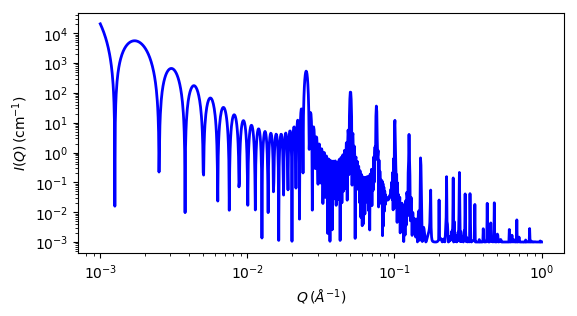lamellar_stack_paracrystal¶
Random lamellar sheet with paracrystal structure factor
Parameter |
Description |
Units |
Default value |
|---|---|---|---|
scale |
Scale factor or Volume fraction |
None |
1 |
background |
Source background |
cm-1 |
0.001 |
thickness |
sheet thickness |
Å |
33 |
Nlayers |
Number of layers |
None |
20 |
d_spacing |
lamellar spacing of paracrystal stack |
Å |
250 |
sigma_d |
Sigma (polydispersity) of the lamellar spacing |
Å |
0 |
sld |
layer scattering length density |
10-6Å-2 |
1 |
sld_solvent |
Solvent scattering length density |
10-6Å-2 |
6.34 |
The returned value is scaled to units of cm-1 sr-1, absolute scale.
This model calculates the scattering from a stack of repeating lamellar structures. The stacks of lamellae (infinite in lateral dimension) are treated as a paracrystal to account for the repeating spacing. The repeat distance is further characterized by a Gaussian polydispersity. This model can be used for large multilamellar vesicles.
Definition
In the equations below,
scale is used instead of the mass per area of the bilayer \(\Gamma_m\) (this corresponds to the volume fraction of the material in the bilayer, not the total excluded volume of the paracrystal),
sld \(-\) sld_solvent is the contrast \(\Delta \rho\),
thickness is the layer thickness \(t\),
Nlayers is the number of layers \(N\),
d_spacing is the average distance between adjacent layers \(\langle D \rangle\), and
sigma_d is the relative standard deviation of the Gaussian layer distance distribution \(\sigma_D / \langle D \rangle\).
The scattering intensity \(I(q)\) is calculated as
The form factor of the bilayer is approximated as the cross section of an infinite, planar bilayer of thickness \(t\) (compare the equations for the lamellar model).
\(Z_N(q)\) describes the interference effects for aggregates consisting of more than one bilayer. The equations used are (3-5) from the Bergstrom reference:
where
and
for the layer spacing distribution \(w = \exp(-\sigma_D^2 q^2/2)\).
Non-integer numbers of stacks are calculated as a linear combination of the lower and higher values
The 2D scattering intensity is the same as 1D, regardless of the orientation of the \(q\) vector which is defined as

Fig. 50 1D plot corresponding to the default parameters of the model.¶
Source
lamellar_stack_paracrystal.py
\(\ \star\ \) lamellar_stack_paracrystal.c
Reference
M Bergstrom, J S Pedersen, P Schurtenberger, S U Egelhaaf, J. Phys. Chem. B, 103 (1999) 9888-9897
Authorship and Verification
Author:
Last Modified by:
Last Reviewed by: